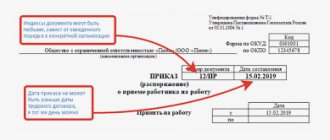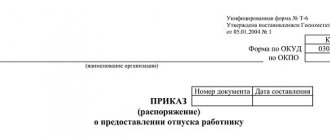Registration of documents is one of the basic procedures in office work. However, not all documents are subject to mandatory registration. We figure out which documents to register and in what form, and also compile a list of documents that do not need registration.
Registration is necessary at the stage of creating a document and in the process of moving it from one organization to another (or government authorities). Without registration, many documents would not have legal force and would not be able to reach the final addressee. The order comes into force only after it has been signed and registered. Outgoing correspondence has official status if it has a registration number. Similarly, a registration index is assigned to an incoming document - and from that moment on, the organization takes responsibility for its execution or use.
The essence of registration is simple: the document must be identified, that is, receive a registration number. In this case, it is necessary to make a registration entry in the accounting documents (magazines, cards). This procedure is important not only for recording documents and monitoring their execution. A document with a unique number is much easier to find in an electronic system, file or paper archive.
Basic principles of registration
Regulatory acts in the field of office work establish general rules for registering documents. The main “handbook” for office workers is the 2021 Rules for Office Work in Federal Executive Bodies, which, among other things, establish the basic principles for registering documents.
You can register a document only once
The one-time principle means that within one organization a document can be registered only once. This principle should be especially remembered in a mixed form of office work, when, along with the registration of paper documents, the organization conducts electronic document flow. There should be no duplicates even if a document registered in the office management service is sent for execution to a structural unit, where information about the document can be updated using the already created registration number.
Registration is carried out within individual groups
Membership in a group is determined depending on the type of document, the number of documents of the same type, author, and content. For example, administrative documents, contracts, official documents, outgoing correspondence
Stick to the terms
Incoming documents are registered on the day they are received, outgoing and internal documents are registered on the day they are signed. Telegrams and faxes must be registered at the time of receipt, after which they are immediately transmitted to the addressee.
Calendar year rule
Documents are registered within a calendar year. During this time, not a single number can be repeated. With the onset of the new year, the “counter” is reset, and documents begin to be registered from the first number, but taking into account the changed date of the calendar year. An exception is the inventory of permanent storage files, which have one number and continuous numbering of items.
Legal aspects
The manager is initially responsible for document flow and office work. And the appointed employee is responsible only for the process of maintaining it. That is, such aspects as staffing, payment, and the number of office management services are determined entirely by the manager. The subordinate only manages and maintains the functionality of the document flow system.
In 2021, Article 15.11 of the Code of Administrative Offenses of the Russian Federation was amended. It states that the punishment for incorrect storage of documents (and this is part of office work) will be imposed on the person responsible in the form of a fine, and in case of repeated violations - disqualification. There is the wording “official”. It can be either a manager or an employee of his organization.
If the manager has signed an order appointing someone responsible for office work and the document has legal force, then the appointed person is responsible for all violations that may be revealed during inspections.
REGISTRATION IS MANDATORY
The records management service must register all documents that require recording, execution and use for reference purposes, regardless of the method of creation and receipt of the document.
In its most general form, these are documents that:
- came from other organizations and individuals;
- internal and sent documents;
- requiring an answer;
- from authorities, higher organizations, etc.
The following are subject to registration in personnel records management:
- orders for personnel;
- employment contracts and additional agreements thereto;
- workers' work books;
- personal files of employees;
- notifications to employees;
- travel certificates;
- certificates issued by the personnel service (about work experience, positions held, etc.);
- minutes of meetings of competition commissions on filling vacant positions and election to positions.
It is also recommended to keep a record of the issuance and delivery of powers of attorney to employees representing the interests of the organization. This will allow you to control the validity period of powers of attorney, and in the event of an employee’s dismissal, it will help you find out whether he has a valid document in his hands.
List of magazines needed for a specific organization
The list of required journals is determined by the area of activity of the organization.
Catering establishments
Catering establishments usually keep a reject log. It records information about the quality of manufactured goods. Grading is a tasting, during which the taste of the product is established and its appearance is checked.
At food enterprises, a commission is formed that is responsible for rejection. It includes these specialists: director, manager, medical worker, senior manager. These employees are responsible for tasting the dishes. The results of the tasting are recorded in the marriage journal. It reflects the smell, consistency of the dish, and its features.
In addition, the enterprise must have a sanitary register.
Enterprises whose work involves harmful emissions
Enterprises whose activities involve harmful emissions must keep environmental logs. These will be considered primary journals. These include these magazines:
- Accounting for emissions into the atmosphere.
- Accounting for water consumption and its disposal.
- Waste movement book.
Keeping environmental logs is strictly regulated by Rosprirodnadzor. If documentation is maintained incorrectly, a fine will be imposed on the company.
There is no single list of unregistered documents
As a general rule, documents received for information and not requiring execution or response are not registered. Typically, a list of such documents is contained in the appendix to the office work instructions. If there are no instructions for office work in the organization, the list of non-registered documents can be approved by order of the head of the organization.
As a rule, unregistered include:
- reports and information sent for information;
- copies of the manager’s orders for core activities;
- copies of administrative documents of a higher organization;
- statistical reporting forms;
- schedules, orders, applications;
- price lists, price lists,
- technical specifications;
- congratulatory letters and telegrams;
- invitation cards;
- advertising notices, posters, event programs;
- curricula, programs;
- printed publications (books, magazines, newsletters, catalogues);
- employees’ correspondence marked “personal” and many others.
If the rules for drawing up documents are violated, the records management service has the right not to register them.
Requirements for the Audit Log
The main requirements of the Federal Law of the Russian Federation No. 294 for this document are:
- numbering;
- firmware;
- certification with the signature of the first manager and the seal of the organization.
All pages are numbered and stitched so that it is impossible to tear out or replace. On the last sheet, the firmware threads are tied together, secured with a mastic seal and certified by the signature of the owner of the individual entrepreneur or director of the LLC. The law does not require its registration with any authorities.
Registration books, books, cards
Journals (books) and cards are used to register documents. These are two historically established forms of recording registration data. With the advent of paper computers, they gradually transformed into electronic journals, databases and, along with other office work procedures, migrated to electronic document management systems.
Registration journals (books)
If the organization has not implemented an electronic document management system, the registration function can be taken over by electronic journals, which are conveniently compiled and maintained in the form of an Excel table. The first line of such a log contains the title of the information field, each subsequent line contains an account.
In most cases, the forms of registration logs are not clearly regulated. If necessary, the contents of rows and columns can be changed, adhering to the principle of complete display of information about the registered document.
The following are conducted in any form:
- Journal of records of certificates and copies of documents issued to employees;
- Journal of incoming correspondence;
- Logbook for outgoing correspondence;
- Personal records log;
- Journal of registration of orders for main activities;
- Logbook for registering orders for personnel;
- Journal of registration of vacation orders;
- Journal of registration of job descriptions;
- Logbook for recording the transfer of personal data of employees within the organization and many others.
The forms of journals and books, the maintenance of which is mandatory, are normatively defined.
- Book of accounting of the movement of work books and inserts in them;
- Receipt and expense book for accounting of work book forms and the insert in it;
- Logbook of inspections of a legal entity, individual entrepreneur, carried out by state control (supervision) bodies, municipal control bodies;
- Journal of industrial accidents;
- Logbook for fire safety briefings;
- Logbook for pre-trip medical examinations of drivers.
Forms of journals recommended by GOST 12.0.004-90 “Interstate standard. System of occupational safety standards. Organization of occupational safety training. General provisions”, approved and put into effect by Decree of the USSR State Standard of November 5, 1990 No. 2797:
- Induction training log;
- On-the-job training log.
A complete list of journals, the maintenance of which is mandatory, recommended or not provided for by the legislation of the Russian Federation, can be found in the summary table.
IMPORTANT! Mandatory maintenance of accounting forms in the form of journals is established by the List of standard management archival documents generated in the process of activities of state bodies, local governments and organizations, indicating storage periods, 2010 (Articles 258, 259,260, 261, etc.). Registration journals (books) are subject to special storage.
Paper registration logs (books) are kept until they are completely filled. The cover indicates the name of the organization, title, date of establishment of the journal (book), and after making the last possible entry - the end date. Any changes to the organization's name or legal ownership must also be reflected on the cover.
It is necessary to register documents in paper journals only if such a requirement is enshrined in legal acts or when there is an objective need for this, for example, in order to avoid disagreements when issuing educational documents and passes. In other cases, electronic journals are a more convenient form of registration.
Registration cards
Registration on paper cards is resorted to if the organization has neither an EDMS nor the ability to maintain electronic journals. The card registration system allows you to register the same document in several card indexes depending on the classifying feature: by author, performer, etc. This type of card index is called reference, or information. It is also possible to create a thematic card index, in which cards are organized according to the classifier of issues related to the organization’s activities. To monitor the execution of documents and instructions, a time-based card file is used.
Since all work in the file cabinet is carried out manually - during registration and during the search for the necessary information, it is extremely unproductive for working with a large volume of document flow, for example, with incoming documents.
The organization independently determines the forms of registration cards and consolidates them in the office management instructions.
Who needs such a magazine and why?
Such a magazine, first of all, is needed by the owner/manager of the enterprise himself. The main role assigned to this document:
- documenting the fact of the inspection;
- fixation of its goals, objectives and results.
Maintaining this document allows the company’s management or its owner to become familiar with the results of the audit in a timely manner and act in accordance with them. The inspection inspector fills out the log with his own hand.
The responsible person for the presence and maintenance of the journal is the owner (for individual entrepreneurs) or the first director of the company (for LLC), unless another person is appointed by order.
If this log is available and filled out correctly, neither party can refuse the fact of conducting verification activities.
Who should register documents?
If the organization conducts office work centrally, then all documentation is registered in the preschool educational institution service. With a mixed form, it is necessary to clearly define which unit and which employee is responsible for registration, as well as establish a list of documents to be registered.
Some internal documents (orders on core activities, memos, reports, etc.) are registered by the records management service. Minutes of meetings - at the place of creation by the person responsible for organizing the event. Internal documentation of structural units is registered in the structural units.
SOURCE: https://naar.ru/articles/registratcionnye-formy-dokumentov-obiazatelnye-rekomendovannye-proizvolnye/
What does the audit log look like?
You can purchase a printed version of the magazine, correctly laid out and divided into pages. Sample forms can be viewed here.
The magazine looks quite simple. It consists of 2 parts:
- title page;
- information about inspections.
Title
The title page indicates:
- name of the organization (full and abbreviated),
- type of ownership;
- legal address of the enterprise;
- OGRN;
- Full name of the manager (in full);
- Full name of the responsible person, if one has been appointed.
The responsible person is appointed officially by the first manager (by order of the enterprise).
Check details
When conducting inspections, the inspector must leave the following information in your log:
- name of the body carrying out the inspection;
- the goals of the audit, its main tasks and subject matter;
- grounds (legislative act allowing/prescribing this type of control actions);
- date and time of the beginning of the procedure and its end;
- results (presence of violations, issued instructions/instructions);
- Full name and signature of the persons/persons carrying out/carrying out the inspection.
If there is a log, this data was not specified or was distorted, this is a violation. If at the time of the inspection the log was not provided to the inspector, this does not cancel the inspection. This point must be indicated in the act drawn up after the inspection.







